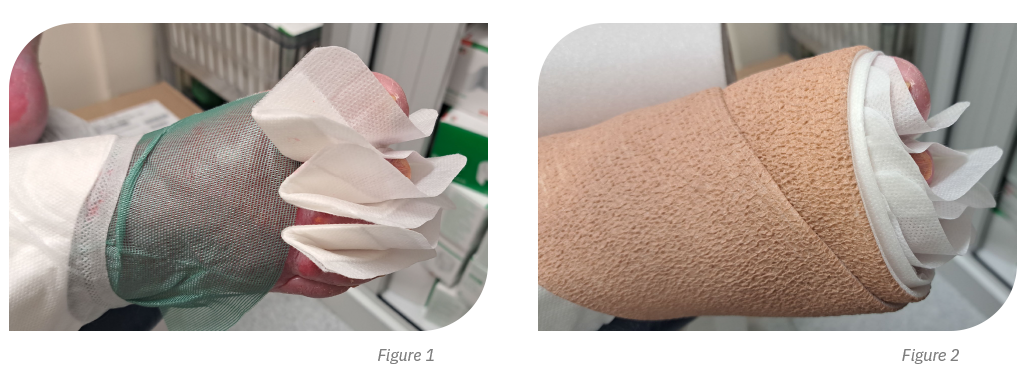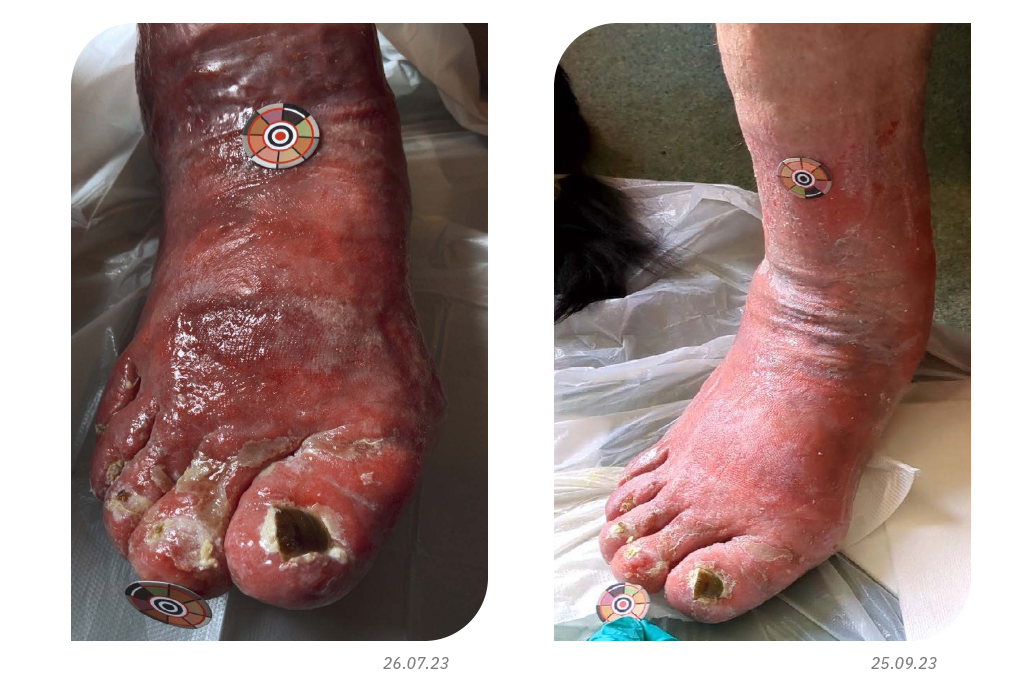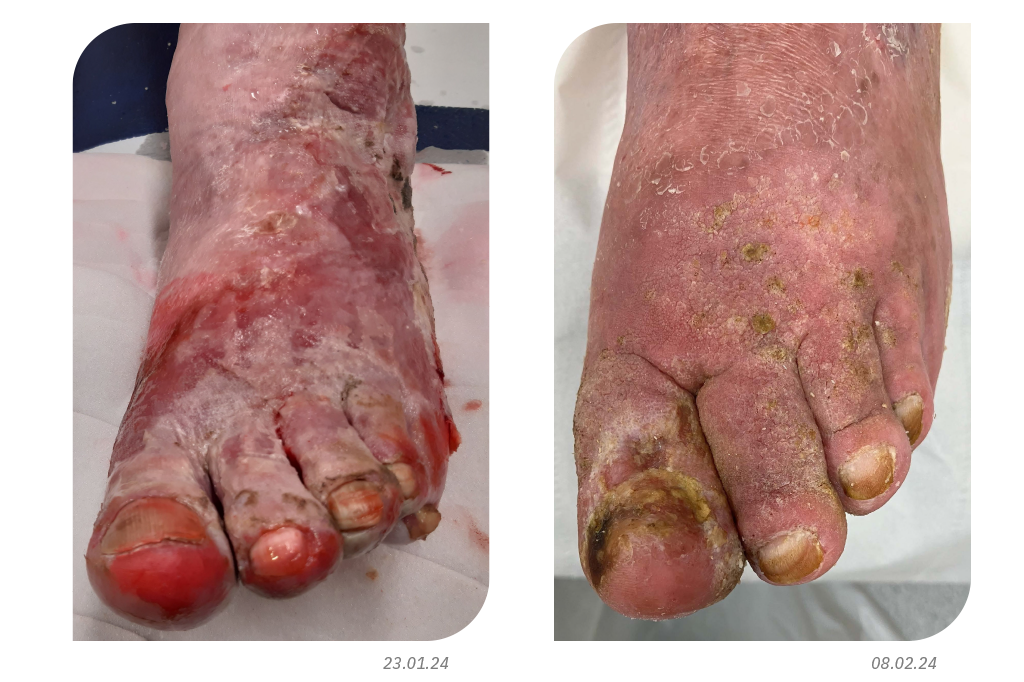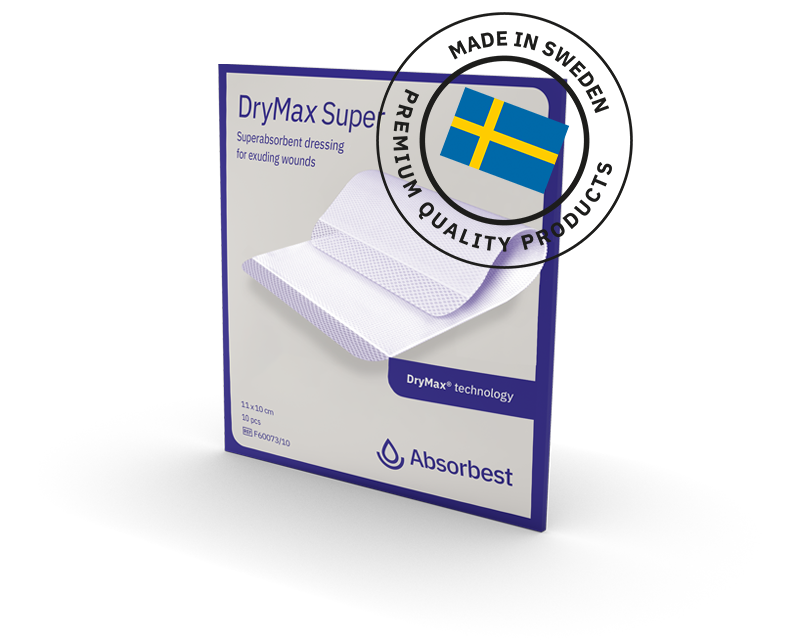Lower limb lymphovenous disease affects the lower leg, foot, and toes. Wet, leaking legs have a significant impact on quality of life and are a burden for the community nursing teamsAnderson I (2016) ‘Leaky legs’: strategies for the treatment and management of lower-limb lymphorrhoea. Nursing Times; 113: 1, 50-53..
While leg lymphorrhoea can be effectively treated with superabsorbent dressings and compression, treating lymphorrhoea in the toes is more challenging. Individual toe bandaging and moccasin boot-style application may not be suitable when there are high exudate levels, and community nursing teams may need to gain the skills to apply them.
In this study, the authors reviewed the options for enhancing the management and outcomes of patients with toe lymphorrhoea.
![]()
A patient case study series was commenced to determine whether a superabsorbent dressing* (already being used under compression to manage leg lymphorrhoea) could also prove effective in managing toe lymphorrhoea.
Patients who presented in the clinic with wet, leaking toes and were suitable for compression were trialled with the 7.5×7.5cm superabsorbent dressings folded between the toes (Figure 1).
Compression bandaging started from the tip of the toes instead of the base (Figure 2). This method was an alternative to toe bandaging or moccasin boot application.

A 78-year-old female with chronic oedema visited the clinic with wet, leaky toes (lymphorrhoea).
The patient was in pain and distressed as pseudomonas infection was present, her skin was excoriated, and the exudate was malodourous. The condition had gradually worsened despite daily care and antibiotics, resulting in the patient being admitted to the hospital for IV antibiotics and bed rest.
Previous treatments included a moccasin-type boot with compression, and the toes were too wet and painful for toe bandaging.
A superabsorbent dressing was commenced to manage lymphorrhoea and toe infection, improve quality of life, ease pain levels, and reduce dressing changes. The dressing was folded between the toes, and compression was applied, with daily dressing changes initially. After discharge, the dressing changes were reduced to every 3rd day.

The patient found the superabsorbent dressings comfortable under compression. District nurses found the dressing easy to apply and remove and built a good rapport with the patient, providing education on sleeping in bed at night and leg elevation. Patient’s quality of life was much improved; she was no longer in distress or pain at dressing changes.
Please provide your details and we will send you a download link to your e-mail.
A 68-year-old male was being treated for a chronic ulcer to the left lateral malleolus. He presented with wet, leaky toes and an excoriated dorsum of the foot. Infection was also present.
Gauze dressing and toe bandaging were attempted initially, but the toes were too wet. The patient found a moccasin boot too restrictive and reported he found the current treatment regimen painful.
Treatment with a superabsorbent dressing was commenced to manage the exudate. The patient wanted his toes free, so the superabsorbent dressing was folded between the toes, with a tubular bandage compression secured over the dressing like a sock.

The outcome found that exudate was managed effectively, and the peri-wound condition improved. The dressing was conformable, flexible and simple to use under compression.
The patient was concordant with treatment and reported that his quality of life improved, and pain levels reduced.
The dressing changes were reduced from 3-4 times per week to twice per week, meaning fewer trips for the patient to visit the practice nurse and reduced nursing time.
![]()
The superabsorbent dressings slotted extremely well between each toe, proving to be an excellent alternative to toe bandaging and an effective method of managing heavily exuding toes. Medical imagery supports these results.
This method of dressing wet, leaking toes is simple and effective and improves patients’ quality of life as exudate is adequately managed and oedema is reduced.

*The superabsorbent dressing used in this evaluation is DryMax Super, manufactured by Absorbest AB, Sweden.
This poster was supported by sponsor from CD Medical Ltd.

Experience the difference and compare the outcome with our superabsorbent dressing. Designed to create a simple wound healing process and optimal healing environments to support clinicians giving quality care.

This complete guide to leg ulcers will help you to understand various wounds, what distinguishes these, and how they can best be treated during and after the healing process.
Anderson I (2016) ‘Leaky legs’: strategies for the treatment and
management of lower-limb lymphorrhoea. Nursing Times; 113: 1, 50-53.